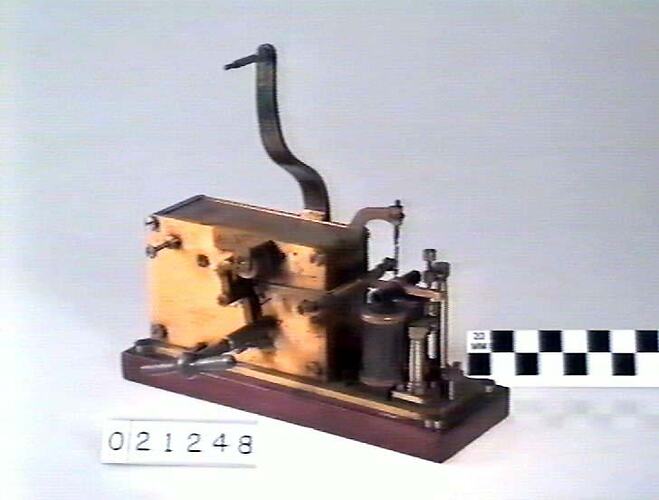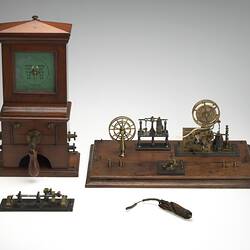Summary
Telegraph embossing register. For receiving and recording telegraph signals.
In operation, the intermittent current generated by the received signals causes the embossing stylus to be intermittently pressed on to a moving paper tape. The stylus embosses a series of long and short marks on the tape, with the length of each mark depending on whether the duration of the current flow is long (producing a dash) or short (producing a dot.) The mechanism which moves the tape is driven by a falling weight.
The object is marked: 'Patent / Siemens Brothers/ London / No. 8150'. The British subsidiary of Siemens & Halske, of Berlin, was set up as Siemens, Halske & Co. in 1858, and was re-named Siemens Brothers in 1865. Thus it seems likely that this object was manufactured in London in or after 1865.
Physical Description
Wooden base carrying brass baseplate at one end of which are two vertical wire coils forming electromagnets. The rest of the base is occupied by a brass case housing the mechanism by which paper tape is moved past a stylus at the end of a pivoted arm which moves in response to the electromagnets. When the stylus is brought into contact with the tape, a mark is embossed into the paper. The tape is supplied from a reel (missing) mounted above the register on a metal arm. The mechanism to move the tape is powered by a spring within the brass case which can be wound up using a key on a central square shaft.
More Information
-
Collection Names
-
Collecting Areas
-
Acquisition Information
Donation from (Estate of) Mr James Alexander Smith, 23 Oct 1939
-
Manufacturer
Siemens Bros Dynamo Works Ltd, London, England, Great Britain
-
Inscriptions
Engraved on side of brass case: 'PATENT SIEMENS BROTHERS LONDON No. 8150'
-
Brand Names
-
Classification
-
Category
-
Discipline
-
Type of item
-
Overall Dimensions
323 mm (Length), 155 mm (Width), 320 mm (Height)
-
Keywords


